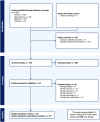Cardiac output monitors in septic shock: do they deliver what matters? A systematic review and meta-analysis
- PMID: 40652247
- PMCID: PMC12255103
- DOI: 10.1186/s13054-025-05547-9
Cardiac output monitors in septic shock: do they deliver what matters? A systematic review and meta-analysis
Abstract
To evaluate the interchangeability of cardiac output (CO) monitoring devices compared to reference methods in adult ICU patients with septic shock, we systematically searched electronic databases through January 2025 for prospective studies comparing CO monitors with pulmonary artery catheter (PAC), transpulmonary thermodilution (TPTD), or echocardiography. Eligible studies included Bland-Altman analysis and, when available, trending assessment via polar or 4-quadrant plots, precision, and time response. Agreement was defined as percentage error (PE) < 30%, and acceptable trending as concordance ≥ 90%. Pooled bias, limits of agreement (LoA), and PE were calculated using the Sidik-Jonkman random-effects model. Twenty-six studies were included, yielding 37 unique device-reference datasets and encompassing 1,323 patients. PAC was the most common reference (18 datasets), followed by TPTD (16) and echocardiography (3). The pooled bias was 0.15 L min⁻¹ with LoA of ± 3.45 L min⁻¹ and pooled PE of 49%. Calibrated pulse contour analysis (PCA) showed the best agreement (PE 25%), whereas uncalibrated PCA, thoracic electrical bioimpedance, and bioreactance demonstrated poor agreement (PE ≥ 52%). Heterogeneity for mean bias was high across all subgroups (I² >80%). Of 15 datasets reporting trending, only three achieved concordance ≥ 90%. Most CO monitors demonstrate poor agreement with reference methods in septic shock. However, their true clinical utility remains unclear, as usual validation frameworks-centered on Bland-Altman analysis-overlook metrics that matter most to intensivists. Precision, time response, and trending ability are critical for real-time decision-making but were rarely assessed. Future studies must incorporate these parameters to meaningfully evaluate device performance at the bedside. PROSPERO registration: CRD42024509384.
Keywords: Cardiac output; Hemodynamic monitoring; Meta-analysis; Pulmonary artery catheter; Septic shock.
© 2025. The Author(s).
Conflict of interest statement
Declarations. Ethics approval and consent to participate: This study is a systematic review and meta-analysis of previously published literature and did not require approval from an institutional review board or consent to participate. Consent for publication: Not applicable. This study does not contain any individual person’s data in any form (including individual details, images, or videos). Competing interests: The authors declare no competing interests.
Figures




Comment in
-
Not all pulse contour algorithms are created equal.Crit Care. 2025 Jul 30;29(1):336. doi: 10.1186/s13054-025-05589-z. Crit Care. 2025. PMID: 40739236 Free PMC article. No abstract available.
Similar articles
-
Validation of maternal cardiac output assessed by transthoracic echocardiography against pulmonary artery catheterization in severely ill pregnant women: prospective comparative study and systematic review.Ultrasound Obstet Gynecol. 2017 Jan;49(1):25-31. doi: 10.1002/uog.16015. Epub 2016 Nov 28. Ultrasound Obstet Gynecol. 2017. PMID: 27404397
-
Pulmonary artery catheters for adult patients in intensive care.Cochrane Database Syst Rev. 2013 Feb 28;2013(2):CD003408. doi: 10.1002/14651858.CD003408.pub3. Cochrane Database Syst Rev. 2013. PMID: 23450539 Free PMC article.
-
Fourth Generation FloTrac Software Pulse Contour Analysis for Measuring and Trending Cardiac Output: A Method Comparison Study.Acta Anaesthesiol Scand. 2025 Jul;69(6):e70077. doi: 10.1111/aas.70077. Acta Anaesthesiol Scand. 2025. PMID: 40561193 Free PMC article.
-
Accuracy and precision of calibrated arterial pulse contour analysis in patients with subarachnoid hemorrhage requiring high-dose vasopressor therapy: a prospective observational clinical trial.Crit Care. 2014 Feb 5;18(1):R25. doi: 10.1186/cc13715. Crit Care. 2014. PMID: 24499533 Free PMC article.
-
Falls prevention interventions for community-dwelling older adults: systematic review and meta-analysis of benefits, harms, and patient values and preferences.Syst Rev. 2024 Nov 26;13(1):289. doi: 10.1186/s13643-024-02681-3. Syst Rev. 2024. PMID: 39593159 Free PMC article.
Cited by
-
Not all pulse contour algorithms are created equal.Crit Care. 2025 Jul 30;29(1):336. doi: 10.1186/s13054-025-05589-z. Crit Care. 2025. PMID: 40739236 Free PMC article. No abstract available.
References
-
- Pinsky MR. Hemodynamic evaluation and monitoring in the ICU. Chest. 2007;132(6):2020–9. 10.1378/chest.07-0073. - PubMed
Publication types
MeSH terms
LinkOut - more resources
Full Text Sources
Miscellaneous

